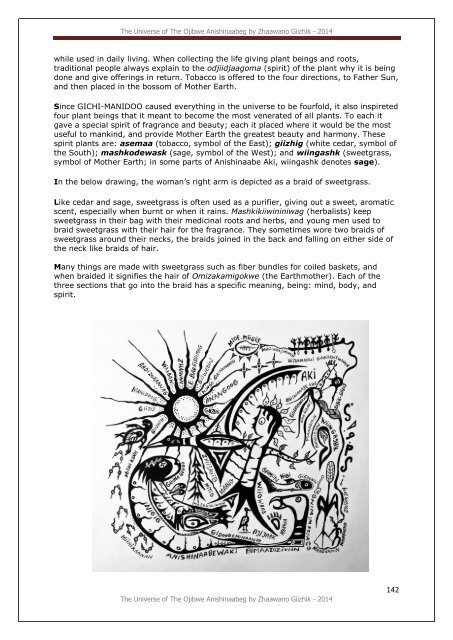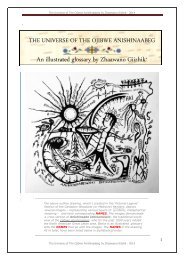The Traditional Anishinaabe World View.pdf
Illustrated glossary offering a cross section of the traditional worldview of the Ojibwe Anishinaabeg, who for the past 1000 years or more inhabit Gaa-zaaga'ekanikaag, the Land of Many Lakes ( the North American Great Lakes area).
Illustrated glossary offering a cross section of the traditional worldview of the Ojibwe Anishinaabeg, who for the past 1000 years or more inhabit Gaa-zaaga'ekanikaag, the Land of Many Lakes ( the North American Great Lakes area).
You also want an ePaper? Increase the reach of your titles
YUMPU automatically turns print PDFs into web optimized ePapers that Google loves.
<strong>The</strong> Universe of <strong>The</strong> Ojibwe <strong>Anishinaabe</strong>g by Zhaawano Giizhik - 2014<br />
while used in daily living. When collecting the life giving plant beings and roots,<br />
traditional people always explain to the odjiidjaagoma (spirit) of the plant why it is being<br />
done and give offerings in return. Tobacco is offered to the four directions, to Father Sun,<br />
and then placed in the bossom of Mother Earth.<br />
Since GICHI-MANIDOO caused everything in the universe to be fourfold, it also inspireted<br />
four plant beings that it meant to become the most venerated of all plants. To each it<br />
gave a special spirit of fragrance and beauty; each it placed where it would be the most<br />
useful to mankind, and provide Mother Earth the greatest beauty and harmony. <strong>The</strong>se<br />
spirit plants are: asemaa (tobacco, symbol of the East); giizhig (white cedar, symbol of<br />
the South); mashkodewask (sage, symbol of the West); and wiingashk (sweetgrass,<br />
symbol of Mother Earth; in some parts of <strong>Anishinaabe</strong> Aki, wiingashk denotes sage).<br />
In the below drawing, the woman’s right arm is depicted as a braid of sweetgrass.<br />
Like cedar and sage, sweetgrass is often used as a purifier, giving out a sweet, aromatic<br />
scent, especially when burnt or when it rains. Mashkikiiwininiwag (herbalists) keep<br />
sweetgrass in their bag with their medicinal roots and herbs, and young men used to<br />
braid sweetgrass with their hair for the fragrance. <strong>The</strong>y sometimes wore two braids of<br />
sweetgrass around their necks, the braids joined in the back and falling on either side of<br />
the neck like braids of hair.<br />
Many things are made with sweetgrass such as fiber bundles for coiled baskets, and<br />
when braided it signifies the hair of Omizakamigokwe (the Earthmother). Each of the<br />
three sections that go into the braid has a specific meaning, being: mind, body, and<br />
spirit.<br />
<strong>The</strong> Universe of <strong>The</strong> Ojibwe <strong>Anishinaabe</strong>g by Zhaawano Giizhik - 2014<br />
142





